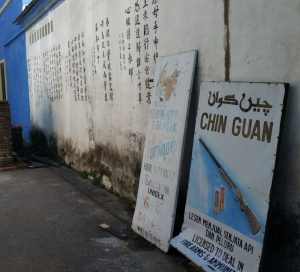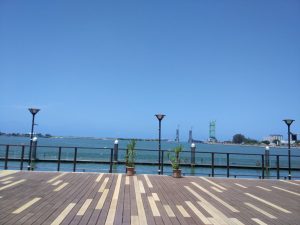 The boatride back was completely different. The sea was very calm, barely a wave. We hoped to see dolphins but instead saw some rather lovely flying fish, dark and round, that flew for metres and looked like earwigs. I call them bumblefish.
The boatride back was completely different. The sea was very calm, barely a wave. We hoped to see dolphins but instead saw some rather lovely flying fish, dark and round, that flew for metres and looked like earwigs. I call them bumblefish.
Then a bus ride back to Kuala Terengganu, and to our hotel. A very minimalist place. The check in process is to be texted your room number and directed to a combination locker containing the key. On checkout, you put the payment and the key back in the locker. Done. The room itself was also commendably minimalist – it had the industrial vibe, with concrete walls and bare fixtures, and nothing in the way of decorations or clutter. A bed, a small table, that’s it. It was very clean aside from the bathroom fan which smelled of mould. A common problem in Malaysia where bathrooms, at least in flats, are so often made without windows.
 We had lunch at Madam Bee’s where we tried the famous laksa (nice but not memorable) and steamed keropok which reminded me unfortunately of what a corpse’s genitals must look like. It was fine, but I prefer the fried variety. Then we tried to go to Pulau Duyong to the boatmaker’s village, but our Grab driver misunderstood and dropped us off at the large, empty and characterless marina. It was extremely hot and seemed like the afternoon was ruined (despite a distant view over the estuary of a half built bridge) but then I found that there was a small ‘fort’ (or rather, house with boundary wall) nearby and we walked there. This was a rather charming and completely empty wooden house, about a hundred years old, with a display on Pulau Duyong’s notables that was clearly created by a single enthusiast. Duyong, it seems, means dugong.
We had lunch at Madam Bee’s where we tried the famous laksa (nice but not memorable) and steamed keropok which reminded me unfortunately of what a corpse’s genitals must look like. It was fine, but I prefer the fried variety. Then we tried to go to Pulau Duyong to the boatmaker’s village, but our Grab driver misunderstood and dropped us off at the large, empty and characterless marina. It was extremely hot and seemed like the afternoon was ruined (despite a distant view over the estuary of a half built bridge) but then I found that there was a small ‘fort’ (or rather, house with boundary wall) nearby and we walked there. This was a rather charming and completely empty wooden house, about a hundred years old, with a display on Pulau Duyong’s notables that was clearly created by a single enthusiast. Duyong, it seems, means dugong.
Then we called a car to take us first to a cafe, then to the floating mosque just outside the town. This was also quite pleasant – the mosque itself was rather chunky, but there was a nice walk around the lake and down to where a river met the sea.
Dinner was at a Chinese place in Kampung Cina, which has quaint painted alleyways and shoplots, and plenty of old school Chinatown shops remaining. What Petaling St may have been like in earlier decades, though with more murals and seemingly fewer brothels.